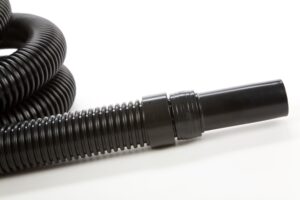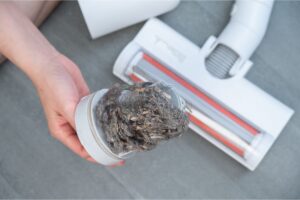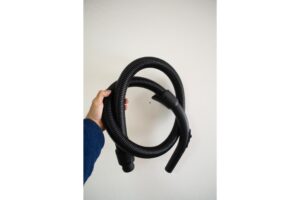Surprising 5 Secrets: How To Clean A Vacuum Cleaner Hose Now
Introduction
Cleaning a vacuum hose seems like a chore, but it helps a lot. I once wondered why my vacuum lost power. Then, I found dust and pet hair stuck inside the hose. If your vacuum isn’t working well, the hose might be clogged. A dirty hose can also trap bad smells and spread dust. The good news? It’s easy to fix. With a few simple steps, you can clear out dirt and blockages. I’ll show you how to clean a vacuum cleaner hose the right way. After this, your vacuum will work better, and your home will stay cleaner!
Signs Your Vacuum Hose Needs Cleaning
Ever turned on your vacuum, only to realize it’s barely picking up dirt? That was me last month, frustrated and convinced my vacuum was broken. Turns out, the hose was clogged with dust, pet hair, and who-knows-what. If your vacuum isn’t working right, your hose might be the problem.
1. Weak Suction Power
If your vacuum isn’t sucking like it used to, the hose could be blocked. A clogged hose reduces airflow, making cleaning less effective. Try removing the hose and checking for obstructions.
2. Bad Odors
Ever noticed a musty or stale smell while vacuuming? A dirty hose can trap dust, mold, and pet hair, causing bad odors. If your vacuum smells funky, it’s time for a deep clean.
3. Dirt Falling Out of the Hose
Lift the hose, and dirt spills out? That’s a sure sign it needs cleaning. Debris builds up over time and can even cause blockages. A quick shake or tap might reveal just how much gunk is hiding inside.
4. Strange Noises While Vacuuming
If you hear whistling or rattling sounds, your hose might be clogged. When air struggles to pass through, it creates odd noises. Unclogging the hose can bring your vacuum back to normal.
5. Overheating or Auto-Shutting Off
A clogged hose makes your vacuum work harder, leading to overheating. Some models even shut off automatically to prevent damage. If your vacuum keeps turning off, check the hose first.
Cleaning your vacuum hose isn’t just about performance—it’s about keeping your home fresh and dust-free. If any of these signs sound familiar, it’s time for a deep clean!
Tools and Materials You’ll Need
Before you start cleaning, gathering the right tools will make the job easier. I’ve made the mistake of jumping in without the right supplies—trust me, it’s not fun trying to dig out clogs with just my fingers. With a few simple items, you can clean your vacuum hose properly and avoid frustration.
1. Warm Water and Mild Dish Soap
A simple mix of warm water and dish soap helps break down dirt and grime inside the hose. If your hose smells bad, vinegar is a great alternative for deodorizing and killing bacteria.
2. A Long Flexible Brush or Bottle Brush
This tool is a game-changer. It scrubs away dust and buildup inside the hose, reaching spots you can’t see. If you don’t have one, a cloth wrapped around a broomstick can work too.
3. A Broomstick or Wire Hanger
Stubborn clogs? A broomstick helps push out debris stuck inside. Just be gentle to avoid damaging the hose. A straightened wire hanger can also work for smaller clogs.
4. Baking Soda (For Odor Control)
Sprinkling baking soda inside the hose before washing can help absorb lingering smells. It’s an easy way to freshen up your vacuum.
5. Towel or Drying Rack
After washing, the hose needs to dry completely to prevent mold. Propping it up on a drying rack or hanging it over a towel works best.
Having these tools ready will make cleaning quicker and more effective. A little prep goes a long way in keeping your vacuum working like new!
How to Clean a Vacuum Cleaner Hose (Step-by-Step Guide)
Cleaning a vacuum hose seems small, but it helps a lot. The first time I cleaned mine, I was shocked. So much dirt was trapped inside! My vacuum worked better, and the bad smell disappeared. If your vacuum has weak suction or smells bad, follow these simple steps.
Step 1: Detach the Hose

First, unplug your vacuum. Then, remove the hose by twisting or unclipping it. Each brand is different, so check your manual if needed. If the hose is stuck, wiggle it gently. Don’t pull too hard—it might break.
Step 2: Remove Visible Debris

Shake the hose over a trash can. This removes loose dirt. If there’s a clog, use a broomstick or wire hanger to push it out. You can also tap the hose on the floor to loosen stuck debris.
Step 3: Wash the Hose Thoroughly

Wash the Hose Thoroughly
Fill a sink with warm, soapy water. Dish soap and vinegar work well. Submerge the hose and scrub inside with a bottle brush. Move the brush in circles to loosen dirt.
Step 4: Rinse and Disinfect

Rinse and Disinfect
Run clean water through the hose to remove soap. For extra freshness, pour in a baking soda and water mix. This helps remove bad smells.
Step 5: Dry the Hose Completely

Shake out water, then let the hose air dry. Hang it over a shower rod or lay it on a drying rack. Before using it again, make sure it is completely dry. Any moisture left inside can cause mold.
A clean vacuum hose makes a big difference. Try it, and you’ll see how much better your vacuum works!
Special Cleaning Instructions for Different Vacuum Brands
Not all vacuum hoses are the same. Some detach easily, while others take a little effort. I learned this the hard way when cleaning my Dyson for the first time! Here’s how to clean hoses for different vacuum brands.
Dyson Vacuum Cleaner Hose
Dyson hoses can be tricky. First, detach the hose by pressing the release buttons. Then, check for blockages by holding it up to the light. If clogged, push debris out with a broomstick. Wash with warm, soapy water and let it dry completely before reattaching.
Shark Vacuum Hose
Shark vacuums often have two hose sections. Remove both and clear out any visible dirt. If clogged, use a wire hanger to pull debris out. Wash the hose with vinegar and water to remove odors. Give it a full day to air dry.
Rainbow, Miele, Hoover, and Bissell Hoses
These brands often have longer, flexible hoses. Remove the hose carefully and shake out loose dirt.Soak it in warm, soapy water for a thorough washing. Scrub with a bottle brush, rinse well, and let it dry fully before reattaching.
Different vacuums need different care, but a clean hose makes all the difference. Try these steps, and your vacuum will work like new again!
How to Unclog a Vacuum Hose
Last week, my dog shed all over the house. When I tried to clean up, my vacuum made a sad noise and just stopped picking up hair. The hose was stuck full of fur! If your hose is clogged too, don’t panic. You can fix it fast with what you have at home.
How to Tell If Your Hose Is Clogged
How do you know if your hose has a clog? Pick up the end and look through it. If you can’t see light, it’s blocked. You might also hear a high whistle when you turn on the vacuum. This means air can’t flow well.
Easy Ways to Unclog Your Hose
The best way to clear a clog is to use a broom handle. Take off the hose first. Push the handle in from one end to pop out the clog. Go slow so you don’t harm the hose.
Got a wire coat hanger? Make it straight and use it for small clogs. Twist as you push to grab hair and dust. I once pulled out a toy car my kid lost months ago!
Try Water for Sticky Clogs
If the clog won’t budge, try water. Fill your sink with warm, soapy water. Dip the hose in and let it soak for 15 minutes. The water helps break down stuck gunk. How do you know it’s working? You’ll see dirt start to float in the water.
Use a Long Brush for Tough Jams
A baby bottle brush works great on tough clogs. Push it through the hose and twist to grab the mess. You can find long, thin brushes made just for hoses at most stores. They cost about $5 and work so well.
Try Air Pressure Tricks
No tools handy? Try this neat trick! Block one end of the hose with your hand. Turn on the vacuum and let it run for a few secs. Then, quick – put that end on the output port where air blows out. The burst of air can push clogs right out!
The Garden Hose Method
For the worst clogs, try a garden hose. Take your vacuum hose outside. Put the garden hose in one end and turn on the water. The rush of water can push out most clogs. Just make sure to let the hose dry fully for a day after!
When to Stop and Get Help
If you hear a crack or see the hose start to stretch too much, stop right away. It’s not worth breaking your hose. Some clogs are just too stuck, and you might need a new hose. A new hose costs less than a new vacuum!
I once spent an hour trying to fix a clog, only to find a sock stuck deep inside. Some things just won’t come out! How can you tell when to quit? If you’ve tried three methods and still can’t see through the hose, it might be time for a new one.
Clogs happen to all of us. The best tip? Stop them before they start by not sucking up big stuff. With these easy fixes, your vacuum will work like new again in no time!
How to Prevent Future Clogs and Odors
Last spring I spent a whole day fixing my clogged hose. Not fun at all! Since then, I found ways to keep it from happening again. Truth is, it’s way easier to stop clogs than to fix them. Here’s what works for me.
Check What You’re Vacuuming
The best way to stop clogs is to watch what you suck up. I once let my kid’s LEGO get in, and it got stuck. Now I look at the floor first. Pick up big things like coins, clips, and toys before you start. Your hose will last much longer this way.
Empty Your Vacuum Often
Don’t wait till your vacuum is full to dump it. When the dust bin gets too full, dirt goes back in the hose. I dump mine when it’s two-thirds full. It helps a lot! When you empty it more, less dirt backs up. This keeps air flow strong and stops bad smells too.
Use Baking Soda for Fresh Smell
Put some baking soda on your rug once a month before you clean. It soaks up smells and keeps your hose fresh. Last time I did this, my whole house smelled nice! Give it ten to fifteen minutes to sit. Then just vacuum it up. This trick stops smells before they can stick in your hose.
Keep Pet Hair In Check
If you have pets like me, you know hair is a big deal. My dog sheds enough to make a new pet! Brush your pets often to catch loose fur. For hair on chairs, use a wet glove to pick it up first. Less hair in your vacuum means fewer clogs in your hose.
Set Up a Quick Monthly Check
Mark a day each month to check your hose. I do mine on the first Sunday, right when I change my air filters. Hold it up to a light to see if stuff is stuck. A quick look can find small clogs early. Just one minute of checking saves hours of work later.
Rinse After Wet Messes
If you suck up wet things, like spilled coffee grounds, rinse your hose right away. Damp stuff sticks to hose walls and traps more dirt. After you rinse, let it dry all the way. This stops mold and those bad smells that are hard to get rid of.
Try a Drop of Oil for Scent
For a nice smell, add one drop of oil to your filter or dust bag. I like lemon or mint, but any scent works! This keeps your vacuum fresh without a strong smell in your home. The light scent helps mask any old smells in the hose.
Don’t Vacuum Fine Dust
Tiny bits like wall dust, flour, or ash can clog filters and coat your hose. When I fixed my bath, I made this mistake! For these messes, use a shop vac made for fine dust, or just sweep. Keeping fine dust out stops that hard-to-clean gunk from forming.
Store Your Vacuum Right
Don’t bend or twist your hose when you put it away. I hang mine on a hook to keep it straight. Good storage stops hose harm and lets wet spots dry out. A straight, well-kept hose won’t trap dirt in bent parts or start to smell.
Five minutes of care now saves hours of work later! What’s your best tip for keeping your vacuum clean? I’d love to hear what works for you!
Troubleshooting Common Problems
Ever had days when your vacuum acts up? Last month, mine made odd noises and smelled bad. I’ve fixed lots of vacuums over the years. Now I’ll share my best tips for fixing common hose problems.
Persistent Bad Smells Quick Answer: Mix water and vinegar in equal parts. Run it through the hose. Add baking soda and let it sit all night to fix bad smells.
Does your hose have that odd, musty smell? I had this issue when I sucked up wet leaves once. First, make sure your hose is dry. A bit of water can make it smell bad. I like to mix water and vinegar to fix this. It kills the tiny germs that make bad smells. Then I put some baking soda in the hose. I let it sit all night. It works so well!
Hose Still Clogged After Cleaning Quick Answer: Got a tough clog? Use a long, thin wire tool to break it up. Then wash with warm, soapy water.
Some clogs just won’t budge with normal cleaning. Just last week, my hose stayed stuck after I tried the usual tricks. Here’s what I did: I got a long, thin wire tool. These are made to clear drains. I used it to break up the stuck stuff. Then I ran warm, soapy water through it. Just be gentle when you do this. You don’t want to hurt the hose while you fix it.
Kinked or Damaged Hose Quick Answer: Soak small kinks in warm water. This makes the hose soft so you can fix its shape. Bad damage means you need a new hose.
See a bent or twisted hose? Don’t worry! Small kinks can be fixed. Put the bent part in warm water for about 15 mins. This makes the hose soft and easy to shape. Then smooth it out with care. But be real with yourself. If you see splits or tears, you’ll need a new hose. I once tried to fix a split hose with tape. Big mistake!
Suction Problems That Won’t Go Away Quick Answer: Look at both ends where the hose fits. Check for worn-out parts. Run your hand along the hose to feel for tiny holes.
Weak suction isn’t always from clogs. Last month my hose was clean, but it still didn’t work well. I found tiny holes I couldn’t see! Try this: run your hand on the hose while it’s on. You might feel air leaks. Also check where the hose fits on the vacuum. Even a loose fit can cause issues. Often, just putting it back on right fixes it all.
Fixing these issues has saved me lots of stress. It’s worth taking time to fix things right. Then you won’t have to deal with a bad vacuum. What vacuum tricks have you tried? I’d love to hear what worked for you!
Remember, a good vacuum makes cleaning so much easier. These fixes have helped me keep mine running great. Now you can try them too! Just take it slow and be careful. Your vacuum will thank you with better cleaning power.
Have you ever had weird vacuum problems? Share your story! I bet you’ve found some clever fixes too. Together we can help each other keep our homes clean with less stress.
I’ve learned all this from years of trial and error. Now I can spot most hose problems fast. Better yet, I know how to fix them! Keep these tips handy. You can’t predict when you’ll require them.
FAQs
Quick Answer: Key concerns about vacuum hose cleaning include frequency, best cleaning methods, dealing with odors, and proper maintenance.
How often should I clean my vacuum hose? Clean your vacuum hose once every three months. If you have pets or use your vacuum a lot, clean it monthly. You’ll know it’s time when you see dirt falling out or smell odd scents.
What’s the best way to clean a vacuum cleaner hose? Take off the hose. Shake out loose dirt. Wash it in warm, soapy water. Use a long brush to scrub inside. Rinse well. Before applying it once more, let it completely dry.
Can I clean my vacuum hose with bleach? Don’t use bleach. It can harm the hose. Use mild soap and warm water instead. For tough smells, try white vinegar and water mixed in equal parts.
How can I tell if the hose on my vacuum is clogged? Look through the hose at a light. If you can’t see through it, it’s clogged. Other signs are weak suction, dirt falling out, or weird noises when you vacuum.
How do I clean a smelly vacuum hose? Mix equal parts water and vinegar. Run it through the hose. Then sprinkle baking soda inside. Let it sit overnight. Rinse well the next day.
What’s the fastest way to unclog a vacuum hose? Use a broomstick to push out clogs. Or try this trick: Put one end on the vacuum’s exhaust port while it’s running. The air blast often clears clogs fast.
How long should I let my vacuum hose dry after cleaning? Let your hose dry for 24 hours. Hang it straight or prop it up so water drains out. Make sure it’s fully dry to stop mold from growing.
Can I clean different brand vacuum hoses the same way? Yes, most vacuum hoses clean the same way. But check your manual first. Some brands like Dyson, Shark, or Rainbow might need special care.
How do I clean a vacuum hose without taking it apart? Run warm, soapy water through the hose while it’s still on the vacuum. Then run clean water through it. Let it dry well. But taking it off works better.
What should I avoid sucking up to keep my hose clean? Don’t vacuum wet stuff, big items, or fine dust like ash or flour. Pick up large things by hand. These steps keep your hose clean longer.
Have any tips helped clean your vacuum hose? Share below! Your story might help others with the same problem.
Conclusion
Quick Answer: Clean your vacuum hose every few months with simple tools like warm water, soap, and a brush to keep it working well and smelling fresh.
You know what? A clean vacuum hose makes such a big change! I still recall how amazed I was the first time I cleaned mine. The suction got so much better! Who knew such a simple fix could help so much?
Here’s what I want you to take away: Don’t wait for your vacuum to act up. Check that hose now and then. A quick look can save you lots of work later. Most clogs start small. Catch them early, and they’re easy to fix.
Think of your vacuum hose like a straw. When it’s clear, things flow well. But let it get dirty, and nothing works right. I used to skip cleaning mine. Big mistake! Now I know better. A bit of care goes far.
I’ve shared all my best tips with you. Some I learned from books. Others came from years of trial and error. They all work! Choose the ones that best meet your requirements. Your vacuum will run better, and your home will stay cleaner.
Got a vacuum hose issue right now? Try these fixes! I bet they’ll help. And hey, if you find a new way to clean your hose, let me know. I love learning new tricks too! After all, we’re in this together, making our homes cleaner one vacuum at a time.
Have you tried cleaning your vacuum hose yet? How did it go? Share your story in the comments! Your tips might help others too. Let’s help each other keep our homes clean and our vacuums running strong!
Remember, a happy vacuum means a cleaner home. Now go check that hose! What you discover may surprise you. But don’t worry – now you know just what to do about it!
To Know more about The Best Way How To Bake A Sweet Potato In A Toaster Oven, Please visit our Blogs section
External link for more info


1 thought on “Surprising 5 Secrets: how to clean a vacuum cleaner hose Now”